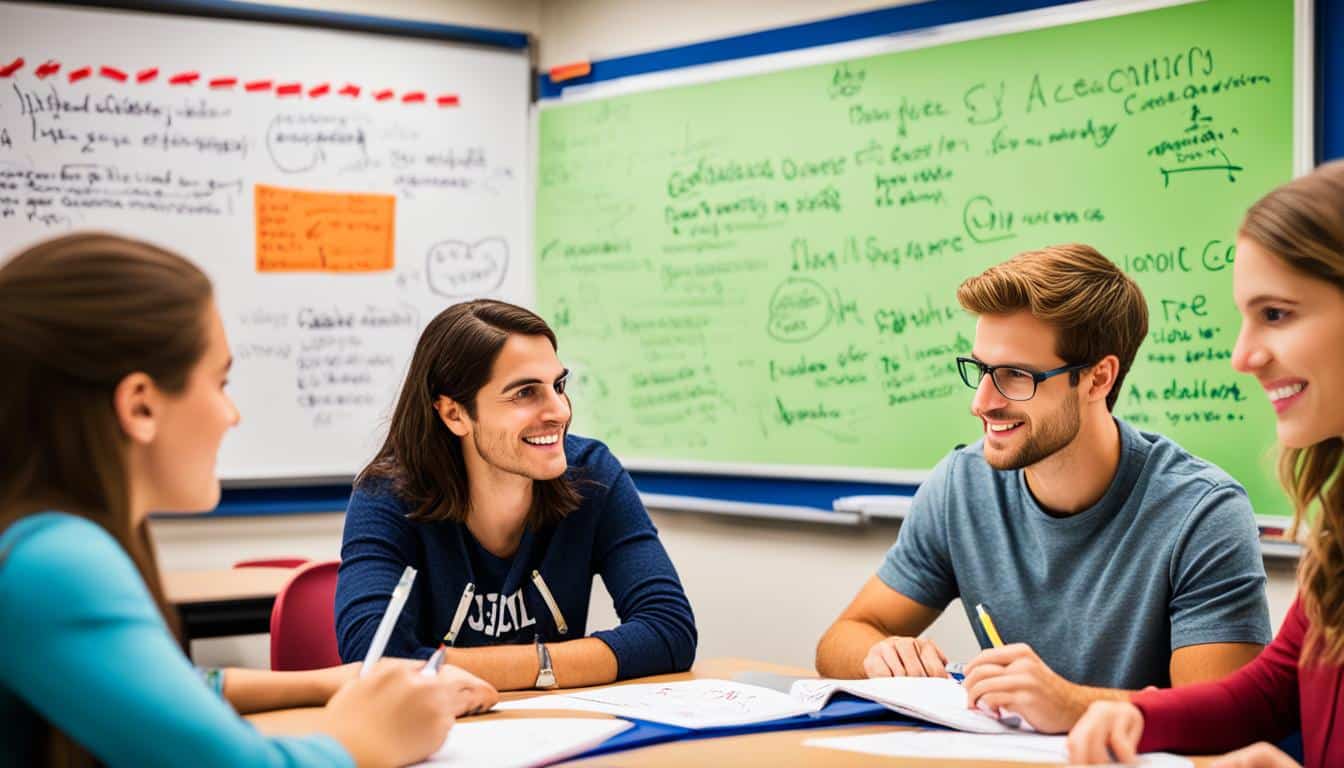Table of Contents
ToggleSecondary education is an important phase in a student’s academic journey, providing a range of benefits that contribute to their personal and academic development. As the next level of schooling after primary education, secondary education prepares students for higher education or the workforce, equipping them with the necessary knowledge and skills for future success.
Secondary education, often referred to as high school or secondary school, offers a more specialized curriculum that builds upon the foundational knowledge acquired in primary education. It covers the ages of 12 to 18 and exposes students to a diverse range of academic disciplines such as mathematics, science, languages, social sciences, and the arts.
In addition to academic development, secondary education plays a pivotal role in shaping students’ personal growth and fostering essential life skills. It encourages critical thinking, creativity, and social and emotional development through various learning opportunities in the classroom and extracurricular activities. Moreover, secondary education promotes active citizenship, civic engagement, and a sense of social responsibility.
As secondary education systems vary worldwide, it is essential to understand the different structures and approaches employed by various countries. Some countries have a unified system, while others offer different educational tracks based on students’ interests and career goals. This diversity allows students to choose pathways that align with their ambitions and aspirations.
In conclusion, secondary education offers a wealth of benefits, including academic growth, personal development, preparation for higher education or the workforce, and societal impact. It empowers students to discover their passions, develop critical skills, and become responsible and engaged citizens. With its transformative potential, secondary education plays a vital role in shaping the future of individuals and society as a whole.
Key Takeaways:
- Secondary education prepares students for higher education or the workforce.
- It offers a specialized curriculum that builds upon primary education.
- Secondary education fosters personal growth and essential life skills.
- It promotes active citizenship and civic engagement.
- Secondary education varies in structure and approaches worldwide.
Also Read : Unlock Your Future With An Education Degree
Definition and Overview of Secondary Education
Secondary education, also known as high school, follows primary education and caters to students between the ages of 12 and 18. It builds on the foundational knowledge acquired in primary school and offers a more specialized curriculum to prepare students for future academic or career pursuits.
Secondary education can be further categorized into lower secondary and upper secondary levels. Lower secondary education, also known as junior high school or middle school, serves as a transition period from primary to upper secondary education. It introduces students to a wide range of subjects and helps them explore their interests.
Upper secondary education, commonly referred to as high school, offers more specialized subjects and allows students to choose elective courses based on their interests or career goals. It provides a platform for students to deepen their knowledge in specific areas and develop the skills necessary for higher education or the workforce.
Secondary education plays a crucial role in shaping the intellectual and personal growth of students. It equips them with the knowledge, critical thinking, and problem-solving skills needed to navigate complex challenges in the modern world.
Also Read : Top 20 Educational Tools for Engaging Learning Experiences
“Secondary education is the gateway to higher learning and career opportunities, providing students with the necessary foundations for success in their future endeavors.”
To provide a visual overview, here is a table highlighting the main characteristics of secondary education:
| Level | Name | Age Range | Description |
|---|---|---|---|
| Lower Secondary | Junior High School/Middle School | 12-15 | Transition period from primary to upper secondary education. Introduction to various subjects |
| Upper Secondary | High School | 15-18 | More specialized subjects. Elective courses based on interests or career goals |
By providing a well-rounded education, secondary schools contribute to the holistic development of students, preparing them for a successful and fulfilling future.
Also Read : Earn Your Early Childhood Education Degree Online
Structure of Secondary Education Systems Worldwide

Secondary education systems vary worldwide, reflecting each country’s cultural, social, and economic contexts. The structure of secondary education can be classified into two main categories: unified systems and tiered approaches involving different educational tracks.
Also Read : Different Types Of Government Jobs In USA
Unified System:
In countries with a unified secondary education system, students follow a standardized curriculum and progress through the same educational pathway. This system ensures that all students receive a comprehensive education and have equal access to opportunities.
Tiered Approach:
Other countries adopt a tiered approach, offering different educational tracks or streams. These tracks can focus on academic subjects, vocational training, or both, catering to students with diverse interests and career aspirations.
The duration of secondary education varies across countries. Some countries offer three-year programs, while others have longer programs lasting up to five or six years. Grading systems, assessments, and teaching methods also differ, reflecting the specific pedagogical practices and priorities of each country.
Comparison of Secondary Education Systems
| Country | System | Duration |
|---|---|---|
| United States | Unified System | 4 years (grades 9-12) |
| Germany | Tiered Approach | 3 years (Hauptschule), 4-6 years (Realschule/Gymnasium) |
| England | Tiered Approach | 5 years (Key Stage 3 and 4) |
| Japan | Unified System | 3 years (lower secondary), 3 years (upper secondary) |
As the table above demonstrates, secondary education systems differ in terms of their structure, duration, and classification. These variations highlight the diverse approaches taken by countries to meet the educational needs of their populations and to prepare students for their future endeavors.
Also Read : When Should You Consider Enrolling At The American Colleges Of Education?
Importance of Secondary Education in Personal Development

Secondary education is a critical phase in a student’s personal development, offering a multitude of opportunities for growth and self-discovery. Through diverse subjects such as literature, history, and the arts, students are exposed to new ideas and perspectives that broaden their knowledge and foster critical thinking skills. The exploration of different disciplines encourages creativity and nurtures a sense of curiosity and intellectual growth.
However, personal development goes beyond academic pursuits. Secondary education also emphasizes social and emotional development through various activities and engagement opportunities. Extracurricular activities such as sports, clubs, and community service provide students with the chance to develop their social skills, build relationships, and practice teamwork. By working collaboratively with peers, students learn to appreciate different perspectives, communicate effectively, and develop leadership qualities. This emphasis on teamwork and collaboration instills essential life skills that are valuable in both personal and professional environments.
Furthermore, secondary education creates an environment that encourages the cultivation of social and emotional intelligence. Through the curriculum and extracurricular experiences, students learn to navigate relationships, develop empathy, and understand the impact of their actions on others. This focus on social and emotional development equips students with the necessary tools to build meaningful connections, resolve conflicts, and contribute positively to society.
“Secondary education nurtures critical thinking, sparks creativity, fosters social and emotional development, and promotes collaboration and teamwork.”
In summary, secondary education plays a pivotal role in personal development by providing a well-rounded education that extends beyond academic knowledge. It encourages critical thinking, creativity, and social and emotional growth, preparing students to navigate the challenges and complexities of life. By equipping students with essential skills and fostering personal growth, secondary education sets the foundation for future success and fulfillment.
Impact of Secondary Education on Society

Secondary education has a profound impact on society, extending far beyond individual students and classrooms. Through its focus on civic engagement, workforce preparation, active citizenship, and social cohesion, secondary education plays a crucial role in shaping a thriving and inclusive society.
Empowering Active Citizenship
Secondary education equips students with the knowledge, skills, and resources needed to actively participate in their communities and contribute to the betterment of society. By emphasizing civic engagement, students learn about their rights and responsibilities as citizens and acquire the tools necessary to become agents of positive change.
Secondary schools provide platforms for students to engage in community service, volunteer work, and leadership opportunities. These activities foster a sense of social responsibility and cultivate empathy, encouraging students to address pressing societal challenges and contribute to the welfare of others.
“Education is the most powerful weapon which you can use to change the world.” – Nelson Mandela
Preparing for the Workforce
Secondary education plays a crucial role in preparing students for the workforce by providing them with essential vocational training, internships, and career guidance. By equipping students with relevant and practical skills, secondary education contributes to the economic growth and prosperity of society.
Vocational training programs offered in secondary schools allow students to learn industry-specific skills and gain hands-on experience. This enables them to enter the workforce fully prepared, contributing to a highly skilled and adaptable workforce in various sectors.
Fostering Social Cohesion
Secondary education fosters social cohesion by promoting a sense of belonging, inclusivity, and mutual respect among students. By bringing together individuals from diverse backgrounds and fostering an inclusive learning environment, secondary schools contribute to the creation of a cohesive society.
Through interactions with peers from different cultures, ethnicities, and socio-economic backgrounds, students develop a deeper understanding and appreciation of diversity. This enhanced awareness leads to greater empathy and cultural sensitivity, laying the foundation for a more harmonious and interconnected society.
The Power of Secondary Education
Secondary education serves as a catalyst for positive societal change. By promoting active citizenship, preparing students for the workforce, and fostering social cohesion, secondary education sets the stage for a more equitable, prosperous, and collectively engaged society.
Academic Benefits of Secondary Education

In the journey of education, secondary education plays a significant role in the academic development of students. It provides a diverse range of subjects and fosters the expansion of knowledge and skills in various disciplines.
Secondary education equips students with essential academic foundations and study skills, preparing them for higher education. By emphasizing critical thinking, problem-solving, and analytical skills, secondary education empowers students to succeed both academically and professionally.
A key aspect of secondary education is the opportunity for students to delve deeper into specific areas of interest. Whether it’s mathematics, science, languages, or humanities, students have the chance to explore subjects they are passionate about, nurturing their intellectual curiosity and driving their academic growth.
This emphasis on knowledge and skills acquisition paves the way for students to excel in higher education. Students who have completed secondary education have a solid foundation to pursue further studies, equipped with the necessary study skills and academic competence.
Recognizing the importance of critical thinking, secondary education nurtures this skill, enabling students to analyze, evaluate, and synthesize information effectively. This ability to think critically is indispensable in academic pursuits, enabling students to engage with complex concepts and develop reasoned arguments.
Benefits of Secondary Education:
- Acquisition and expansion of knowledge and skills in various subjects.
- Preparation for higher education through foundational knowledge and study skills.
- Emphasis on critical thinking, problem-solving, and analytical skills.
- Opportunity to explore specific areas of interest in greater depth.
Secondary education not only provides students with academic knowledge but also equips them with the skills necessary for success in higher education. With a focus on critical thinking, secondary education prepares students to engage with complex ideas, laying the groundwork for their future academic pursuits.
Practical Skills and Career Opportunities in Secondary Education

Secondary education goes beyond academic development, providing students with practical skills that are essential for their daily lives. Alongside core subjects, schools prioritize the acquisition of practical skills such as financial literacy, time management, digital literacy, and organizational abilities. These skills are designed to enhance students’ overall competence, equipping them with the tools necessary to navigate real-world challenges with confidence.
Financial literacy is a particularly vital skill taught during secondary education. Students learn about budgeting, saving, and making informed financial decisions, empowering them to achieve financial stability in adulthood. By understanding key concepts such as taxes, investments, and credit, students develop the necessary skills to manage their finances responsibly.
Time management is another valuable skill taught in secondary education. Students learn how to prioritize tasks, meet deadlines, and effectively allocate their time. These skills enable them to balance academic commitments, extracurricular activities, and personal responsibilities, preparing them for future success in both their personal and professional lives.
“Secondary education equips students with the practical skills needed to navigate real-world challenges and achieve financial stability.”
In today’s digital age, digital literacy is an essential skill. Secondary education programs incorporate digital skills, teaching students how to use technology responsibly and effectively. From basic computer skills to digital communication and problem-solving, students gain the proficiency necessary to thrive in an increasingly digital society.
In addition to practical skills, secondary education also opens up a multitude of career opportunities for individuals. Many professions require a high school diploma or equivalent, making secondary education a stepping stone towards various career paths. By offering vocational programs, internships, and career guidance, secondary education equips students with the skills and qualifications needed to enter the workforce successfully.
Furthermore, secondary education enhances students’ employability by fostering critical thinking, communication skills, and teamwork. These skills are highly valued by employers across industries. The practical skills gained through secondary education, coupled with a strong academic foundation, position individuals for long-term career success and financial stability.
Practical Skills Developed in Secondary Education:
- Financial literacy
- Time management
- Digital literacy
- Organizational abilities
Through practical skill development, secondary education transforms students into well-rounded individuals, ready to navigate the complexities of the real world and seize abundant career opportunities.
| Practical Skills | Benefits |
|---|---|
| Financial literacy | Enables financial stability and responsible decision-making |
| Time management | Enhances productivity and enables effective prioritization |
| Digital literacy | Prepares students for the digital age and enhances career prospects |
| Organizational abilities | Boosts efficiency and aids in personal and professional success |
Personal Growth and Self-Confidence in Secondary Education

Secondary education provides a nurturing environment that fosters personal growth, allowing students to explore their interests, talents, and strengths. Through a diverse range of subjects and extracurricular activities, students have the opportunity to express themselves and discover their true potential. This journey of self-discovery not only enhances personal growth but also builds self-confidence.
One of the main benefits of secondary education is the sense of accomplishment that comes with mastering new skills and knowledge. As students progress through their studies, they gain a deep sense of satisfaction and pride in their achievements. Whether it’s solving complex mathematical equations, delivering a powerful presentation, or creating a work of art, each accomplishment contributes to their personal growth and self-confidence.
“Secondary education is a transformative phase in a student’s life, offering opportunities for self-discovery and personal fulfillment.”
Teachers play a crucial role in supporting students’ personal growth and self-confidence. They provide encouragement, constructive feedback, and create a positive learning environment where students feel safe to take risks and explore their potential. By nurturing their strengths and helping them overcome challenges, teachers empower students to develop a strong sense of self and believe in their abilities.
Secondary education is not solely focused on academic development but also on life skills that contribute to personal growth and self-confidence. Through extracurricular activities, students learn valuable skills such as teamwork, leadership, communication, problem-solving, and resilience. These skills are essential for success not only in further studies but also in their future careers and personal lives.
The personal growth and self-confidence cultivated in secondary education have long-lasting impacts on students’ lives. As they transition into adulthood, these qualities empower them to face challenges, set and achieve goals, and navigate the complexities of the world. They develop a strong belief in their abilities, which opens doors to new opportunities and enables them to make meaningful contributions to their communities and society as a whole.
| Benefits of Personal Growth and Self-Confidence in Secondary Education |
|---|
| Increased self-awareness |
| Improved decision-making skills |
| Enhanced resilience and adaptability |
| Greater motivation and drive |
| Improved relationships and social skills |
Personal growth and self-confidence are invaluable assets that students acquire through their journey in secondary education. These qualities pave the way for a fulfilling and successful future, allowing individuals to embrace their passions, overcome obstacles, and make a positive impact on the world.
Secondary Education and Civic Engagement

Secondary education plays a significant role in promoting civic engagement among students. It provides them with the knowledge and skills to understand complex societal issues and actively participate in the democratic process. Students learn about their rights and responsibilities as citizens, gain awareness of social justice issues, and engage in community service. Secondary education encourages social responsibility and prepares students to be active participants in creating positive change in society.
By emphasizing the importance of community participation, secondary education instills a sense of belonging and responsibility within students. They are encouraged to actively contribute to their local communities through various initiatives such as volunteering, organizing events, or participating in community-based projects. This hands-on experience allows students to apply their knowledge to real-world issues and make a tangible impact.
Engaging students in the democratic process and community participation cultivates a sense of ownership and empowers them to become agents of change in their society.
Through classroom discussions, debates, and civic education programs, secondary education fosters critical thinking, effective communication, and an understanding of diverse perspectives. Students learn how their actions and decisions can affect the broader community, fostering a sense of social responsibility and empathy. This lays the foundation for cultivating engaged and active citizens who are committed to advocating for the rights and well-being of others.
Civic Engagement in Action
Secondary schools often provide platforms for student-led clubs and organizations that promote civic engagement. These clubs encourage students to explore their interests and passions while addressing societal challenges. For example, a student-led environmental club can organize initiatives like tree planting, waste reduction campaigns, or awareness drives to tackle climate change and promote sustainability within their school and community. These activities not only contribute to the betterment of the environment but also foster a sense of civic responsibility and encourage students to take the lead in creating positive change.
Through civic education programs, students gain a deep understanding of the democratic process and the importance of active participation. They learn about the rights and responsibilities of citizens, the electoral system, and the significance of voting. This knowledge empowers students to engage in informed discussions, express their opinions, and contribute to public decision-making. It instills in them a sense of agency and confidence in their ability to effect change.
Civic engagement goes beyond the classroom. Students who actively participate in community service and volunteering develop a sense of empathy and understanding for the challenges faced by marginalized groups. By engaging in activities that address social justice issues such as poverty, homelessness, or access to education, students gain a deeper appreciation for the complexities of society and are motivated to advocate for positive social change.
“Education is the most powerful weapon which you can use to change the world.” – Nelson Mandela
Secondary education plays a crucial role in shaping responsible and informed citizens who actively contribute to a democratic society. By fostering civic engagement, secondary education empowers students to be actively involved in their communities, understand the importance of social responsibility, and work towards creating a more inclusive and just society.
The Role of Secondary Education in Reducing Inequality

Secondary education plays a crucial role in reducing inequality within society by providing equal opportunities for all students, regardless of their background or socio-economic status. It serves as a powerful tool for social mobility, leveling the playing field and creating pathways for individuals to transcend their circumstances and achieve their full potential.
By ensuring access to quality education, secondary education equips students with the knowledge, skills, and resources necessary for personal and academic growth. It empowers individuals to break free from the cycle of poverty and opens doors to a brighter future.
Quality education is not just about academics; it encompasses a holistic approach that nurtures the development of the whole individual. Through secondary education, students gain valuable life skills, critical thinking abilities, and social competencies that enable them to thrive in a rapidly changing world.
Secondary education is a powerful catalyst for change, providing the necessary tools and opportunities for individuals to overcome barriers and create a more equitable society.
It is important to recognize that reducing inequality requires more than just access to education; it also demands comprehensive efforts to address systemic barriers and ensure that resources are distributed equitably. Policies and interventions aimed at promoting inclusivity, fostering diversity, and eliminating discrimination are essential to creating a society where everyone has an equal chance to succeed.
Moreover, it is crucial for secondary education systems to prioritize diversity and inclusion by embracing different perspectives, cultures, and identities. This fosters an environment where all students feel valued, respected, and empowered to contribute positively to society.
Ultimately, the role of secondary education in reducing inequality goes beyond individual success. It has broad implications for social cohesion, economic prosperity, and the overall well-being of communities. By investing in quality secondary education and promoting equal opportunities for all, we can build a more just and inclusive society for future generations.
The Impact of Secondary Education on Reducing Inequality
| Benefits | How it reduces inequality |
|---|---|
| Access to quality education | Ensures equal opportunities for all students, regardless of their socio-economic background, leading to a more level playing field. |
| Social mobility | Allows individuals to transcend their circumstances and break free from the cycle of poverty, contributing to a more equitable society. |
| Academic and personal growth | Equips students with essential knowledge, skills, and resources necessary for success in academics and life, promoting equal chances for personal development. |
| Diversity and inclusion | Prioritizes the embracing of diversity, fostering an environment where all students feel valued, respected, and empowered regardless of their backgrounds. |
| Community impact | Reduces inequality within communities, leading to social cohesion, economic prosperity, and overall well-being. |
Also Read: Understanding What Is Secondary Education
Conclusion
Secondary education is a transformative phase in an individual’s life that goes beyond academic achievement. It plays a significant role in personal development, enhancing critical thinking and communication skills, and preparing students for higher education or the workforce. Through a diverse curriculum and extracurricular activities, secondary education nurtures students’ talents, fosters creativity, and cultivates essential life skills.
Moreover, secondary education has a profound societal impact. It shapes responsible citizens, promoting social cohesion, and empowering individuals to actively engage in their communities. By offering equal opportunities and access to resources, secondary education contributes to reducing inequality, enabling social mobility, and creating a more equitable society.
In summary, secondary education not only provides academic benefits but also has lasting effects on personal development and societal progress. It equips individuals with the knowledge, skills, and values necessary to navigate the challenges of the modern world. As we strive for a better future, investing in quality secondary education is essential for fostering the growth and well-being of individuals and society as a whole.
FAQs
Q: What is the importance of secondary education?
A: Secondary education plays a crucial role in preparing students for higher education and the workforce, equipping them with essential skills and knowledge for their future careers.
Q: What subjects are typically included in secondary education curriculum?
A: Subjects such as mathematics, English, science, history, and foreign languages are commonly part of the secondary education curriculum.
Q: Are vocational education programs available in secondary schools?
A: Yes, many secondary schools offer vocational education programs to provide students with specialized skills and training for specific career paths.
Q: What are the different types of secondary schools?
A: Secondary schools can include comprehensive schools, grammar schools, vocational schools, and private schools, each with their own focus and educational approach.
Q: Is teacher certification required to teach in a secondary school?
A: Yes, teacher certification is typically required to ensure educators have the necessary qualifications and training to teach in secondary schools.
Q: How does secondary education differ from primary education?
A: Secondary education builds upon the foundation laid in primary education and delves deeper into subject areas, preparing students for more advanced learning.
Q: Are examinations a common assessment method in secondary education?
A: Yes, examinations are a common form of assessment in secondary education to evaluate students’ understanding of the material and their academic progress.
Q: What is the importance of secondary education?
A: Secondary education plays a crucial role in preparing students for higher education and the workforce. It provides advanced knowledge and skills necessary for academic and career success.
Q: How does secondary education differ from primary education?
A: Secondary education follows primary education and focuses on more specialized subjects, preparing students for higher levels of learning or entering the workforce.
Q: What are the types of schools that offer secondary education?
A: Secondary education can be provided by state schools, independent schools, and specialized schools focusing on different subjects such as arts, sciences, or vocational skills.
Q: Is secondary education compulsory?
A: In many countries, secondary education is considered compulsory up to a certain age or grade level to ensure all students receive a basic level of education.
Q: How does mathematics play a role in secondary education?
A: Mathematics is a fundamental subject in secondary education, helping students develop problem-solving skills and analytical thinking important for various academic and career paths.
Q: What are some common subjects covered in secondary education?
A: Secondary education covers a wide range of subjects including geography, physical education, general education, and other specialized courses based on the school curriculum.
Q: What is the significance of teacher education in secondary schools?
A: Teacher education ensures that educators are well-trained to deliver quality instruction and support to secondary school students, fostering a conducive learning environment.





